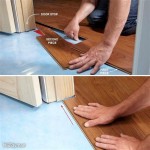Vinyl Plank Flooring Installation: Understanding Labor Costs
Vinyl plank flooring has become a popular choice for homeowners due to its durability, water resistance, and aesthetic appeal. While the material costs are generally affordable, the installation labor can significantly impact the overall project budget. Understanding the factors influencing labor costs is crucial for accurate budgeting and making informed decisions about your flooring project.
This article provides an in-depth analysis of vinyl plank flooring installation labor costs, examining the various elements that contribute to pricing variations and offering insights into how to obtain the best value for your investment. It also touches upon preparation needed before the installation can start.
Factors Influencing Vinyl Plank Flooring Installation Labor Costs
Several key factors contribute to the variance in vinyl plank flooring installation labor costs. These factors relate to the scope of the project, the condition of the subfloor, the complexity of the installation, and the experience and expertise of the installation team.
Subfloor Preparation: The condition of the existing subfloor is a primary cost driver. Vinyl plank flooring requires a smooth, level, and clean surface for proper adhesion and longevity. If the subfloor is uneven, damaged, or has excessive moisture, additional preparation will be necessary. This may involve patching cracks, leveling uneven areas with self-leveling compound, removing old flooring (such as carpet, tile, or linoleum), and applying a moisture barrier. Each of these tasks adds to the overall labor cost. A professional installer will thoroughly assess the subfloor and provide a detailed estimate for any necessary preparation work.
Room Size and Layout: The size of the room directly correlates with the amount of time and labor required. Larger rooms naturally require more material and installation time. Complex room layouts with numerous corners, doorways, and obstructions also increase labor costs. These features necessitate more cuts, precise fitting, and overall attention to detail, extending the installation timeline. Intricate patterns or designs will also require more time for the installer to achieve the desired look.
Type of Vinyl Plank Flooring: The type of vinyl plank flooring being installed also influences labor costs. There are primarily two types of vinyl plank flooring: click-lock (also known as floating floor) and glue-down. Click-lock flooring is generally easier and faster to install, resulting in lower labor costs. These planks interlock with each other, creating a floating surface that does not require adhesive. Glue-down vinyl plank flooring, on the other hand, requires the application of adhesive to the subfloor, which is comparatively a time-consuming process.
Installer Experience and Expertise: The experience and expertise of the installer are critical factors influencing the quality of the installation and the associated labor costs. Experienced installers are typically more efficient and can complete the job faster and with fewer errors. They also possess the knowledge and skills to address unexpected issues that may arise during the installation process and offer valuable advice on subfloor preparation, moisture control, and maintenance. While experienced installers may charge higher hourly rates, their expertise can save time and money in the long run by ensuring a proper and durable installation. Choosing an inexperienced installer may result in a subpar installation and potentially costly repairs or replacements.
Geographic Location: Labor costs vary significantly based on geographic location. Areas with a higher cost of living typically have higher labor rates for home improvement services, including flooring installation. Demand for flooring installers may also influence the price. In regions where there is a shortage of skilled installers, labor costs may be higher.
Additional Services: Additional services, such as furniture removal, baseboard removal and reinstallation, and disposal of old flooring, will add to the overall labor cost. It is essential to discuss these services with the installer beforehand and obtain a detailed breakdown of the associated costs.
Estimating Vinyl Plank Flooring Installation Labor Costs
Estimating the labor cost for vinyl plank flooring installation requires careful consideration of the factors outlined above. While it is difficult to provide a precise estimate without assessing the specific project details, general cost ranges can serve as a starting point. Keep in mind these are approximate averages, and prices fluctuate based on location, material, and contractor.
Per Square Foot: Labor costs for vinyl plank flooring installation are often quoted on a per-square-foot basis. The typical range is between $2 to $7 per square foot, depending on the complexity of the project and the installer's rates. Installing click-lock flooring on a level subfloor in a simple rectangular room will typically fall at the lower end of the range. Glue-down installation or projects requiring extensive subfloor preparation will be at the higher end of the range.
Hourly Rate: Some installers may charge an hourly rate, which typically ranges from $50 to $100 per hour, depending on experience and location. This pricing structure may be more common for smaller projects or projects where the scope of work is difficult to estimate accurately. It's crucial to get a clear estimate of the expected number of hours required to complete the job.
Total Project Cost: To get a more accurate estimate of the total project cost, it is essential to obtain multiple quotes from different installers. Provide each installer with detailed information about your project, including the room size, layout, type of flooring, and any special requirements. Be sure to ask for a written estimate that breaks down the labor costs, material costs, and any additional charges for subfloor preparation or other services. A thorough quote will protect both you and the installer on this project.
When reviewing estimates, avoid simply choosing the lowest bid. Consider the installer's experience, reputation, and customer reviews. A slightly higher price may be worth it for a more reliable and professional installation.
Ways to Potentially Reduce Labor Costs
While professional installation is almost always recommended for best results, certain strategies can help reduce labor costs on your vinyl plank flooring project. These include proper planning, preparation and sometimes, a good relationship with your installer.
DIY Subfloor Preparation: If you are comfortable with basic home improvement tasks, you can potentially reduce labor costs by preparing the subfloor yourself. This may involve removing old flooring, cleaning the subfloor, and patching small cracks or imperfections. However, it's crucial to ensure that the subfloor is properly prepared according to the flooring manufacturer's guidelines. If you are unsure about any aspect of subfloor preparation, it is best to leave it to the professionals. An improperly prepared subfloor can lead to problems with the installation and potentially void the flooring warranty.
Clear the Room: Clearing the room of all furniture and belongings before the installers arrive can save time and labor costs. This allows the installers to focus solely on the flooring installation without having to move heavy items. It also reduces the risk of damage to your furniture or possessions.
Material Procurement: While some installers prefer to supply the flooring materials themselves, you may be able to reduce costs by purchasing the materials yourself. This allows you to shop around for the best prices and potentially take advantage of sales or discounts. However, it's crucial to ensure that you purchase the correct type and amount of flooring for your project. Consult with your installer to determine the specific requirements.
Negotiate the Price: Don't be afraid to negotiate the price with the installer. Obtain multiple quotes and compare them carefully. If you receive a quote that is higher than you expected, politely ask the installer if they are willing to negotiate. Highlight areas where you have already taken steps to reduce costs, such as preparing the subfloor or clearing the room.
Consider a Simpler Layout: Opting for a simpler flooring layout can also help reduce labor costs. Intricate patterns or designs require more cuts and precise fitting, which increases installation time. A straightforward layout with minimal cuts will be faster and less expensive to install.
Timing Considerations: Depending on your location, seasonality impacts contractor availability and potentially pricing. Scheduling the installation during slower periods, such as the fall or winter, may result in lower labor costs.
A level subfloor is extremely important for the longevity of the vinyl flooring, and getting this right at the beginning of the project is vital. The cost of vinyl plank might be relatively cheap compared to other flooring types, but an improperly prepared subfloor can be extremely costly in the long run.
In conclusion, understanding the factors influencing vinyl plank flooring installation labor costs is crucial for accurate budgeting and making informed decisions. By considering all relevant factors, obtaining multiple quotes, and potentially taking steps to reduce costs, you can achieve a beautiful and durable vinyl plank floor within your budget.

Cost To Install Vinyl Plank Flooring S Fixr

Cost To Install Vinyl Flooring Fixr

Cost To Install Vinyl Flooring Fixr

Luxury Vinyl Tile And Plank Flooring Installation Costs

Laminate Flooring Installation Cost Guide Hatcher S Floors

Cost To Install Vinyl Plank Flooring S Fixr

Luxury Vinyl Tile And Plank Flooring Installation Costs

How Much Does Flooring Installation Cost 2025

The Complete Guide To Flooring Costs By Type Twenty Oak

Cost To Install Vinyl Flooring Fixr
Related Posts








